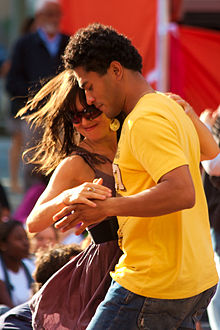The Myth of "Easy dances"
16th March 2012
A wise man once asked, 'Is it better to be feared or respected?' - I say, is it too much to ask for both? ~ Tony Stark, Iron Man
Some background
There's a frequent discussion when dancers of different style mix, about how "easy they are" in comparison to each other.
There's often a "my dance is impossible, you wuss" factor in these discussions also - which tends to make these discussions willy-waving competitions on occasion. Tango dancers are at least as guilty as any others in this regard - we often use the "Pah, it takes us ten years to learn to walk" meme as the ultimate Top Trump of Dance Difficulty.
So I thought I'd throw in a few thoughts on the matter.
MASSIVE CAVEAT
The first thing to say is that I don't believe any common social dances are really "easier" than others - to become a great dancer in any style takes huge amounts of time, effort and dedication. It doesn't matter if it's ballet or balboa, dancing well always requires a lot of time, a lot of effort, and at least some ability.
There are no shortcuts, no magic bullets, no easy path to good dancing. There's no dance form which will somehow mysteriously turn all students into great dancers without any effort. If only.
And similarly, even if a dance were "harder" than another dance, so what? It's not an indication of worth, any more than learning Latin makes someone more "worthy" than learning French.
That out of the way...
What is "Easy"?
"It depends on what the meaning of the word 'is' is" - Bill Clinton
I guess the first question to ask is, what do we mean by "easy"?
Are we referring to:
- The time needed to get started with it?
- The effort involved to achieve a certain level of "fluency"?
- The difficulties of mastering the dance style?
- The relative complexity of the movements?
- Or all of the above?
In fact, we could go into a recursive chain of definition-based discussions on this area, regarding such eternal questions as "What is an advanced dancer?" and suchlike. Endless fun.
But let's not do that.
A Simple Definition: comfortable social dancing
So, for the sake of this article, I'll narrow things down, phrase the question in this way:
"How easy is it for a new student to get to the point where they are comfortable dancing socially?"
After all, social dancing is what social dancers do. We're not trying to measure things artificially based on a structure of syllabi and examinations. Neither are we looking at trying to compare levels on Let's Dance 2 or something.
We're simply trying to get people to be able to dance "comfortably" in a social environment. Where we define "comfortably" as meaning "can enjoy the dance at least a little instead of panicking about it".
Let's look at the basics
One measure of how "easy" a dance might be, by this definition, is to examine the "basic step" (or steps) used within that dance. Many dances have basic or core steps. If these core steps are fairly simple, and if the dance generally uses these core steps commonly, then there's a good chance that the transition to social dancing, at least based on these steps, might be relatively easy.
So in that context, one of the "easiest" dances I've encountered is Merengue.

Basically, the entire dance consists of a series of latin-style weight changes. You can, basically, pretty much do this throughout an entire track.
Likewise, some types of Blues dance are based around a similar type of step (although obviously in a different style).

Obviously, in both dances you can improvise and change, but the basic step is very simple. Step from side to side, on the beat. From my personal experience, I'd say that these basic steps mean that it's very easy / quick to get dancing in those dance forms - although obviously that's not the same as saying it's easy as a dance form.
So there's some evidence from personal experience of this correlation.
And what about Tango?
(For the sake of sanity, I'll ignore the so-called "Basic Step" here. It's rubbish.)
If one looks at Tango, one can reasonably say that there are five "basic steps":
- Forwards
- Backwards
- Side
- Transfer
- Pivot
In fact, those are technically the only steps in Tango. So the basic steps are the only steps... well, sort of.
In my opinion, the closest thing in tango to a "default step" is a leader step forward / follower step back (a walk). And it's fairly easy to walk - well, for the leader, at least.
So is Tango easy?
Well... sort of. I can get a couple to walk in Tango close embrace in 5 minutes (4 of which will be explaining the posture to the follower). In fact, I've often started total-beginner workshops with no instruction whatsover - just playing music and getting the partners to walk around the room in practice hold to that music.
So walking is easy. We can all do it, at least well enough to get started social dancing. OK, fair enough, we look a bit silly, like we're marching at the start. But then all dancers look silly when they're beginners, at any dance style.
~ David Bailey, 16th March 2012